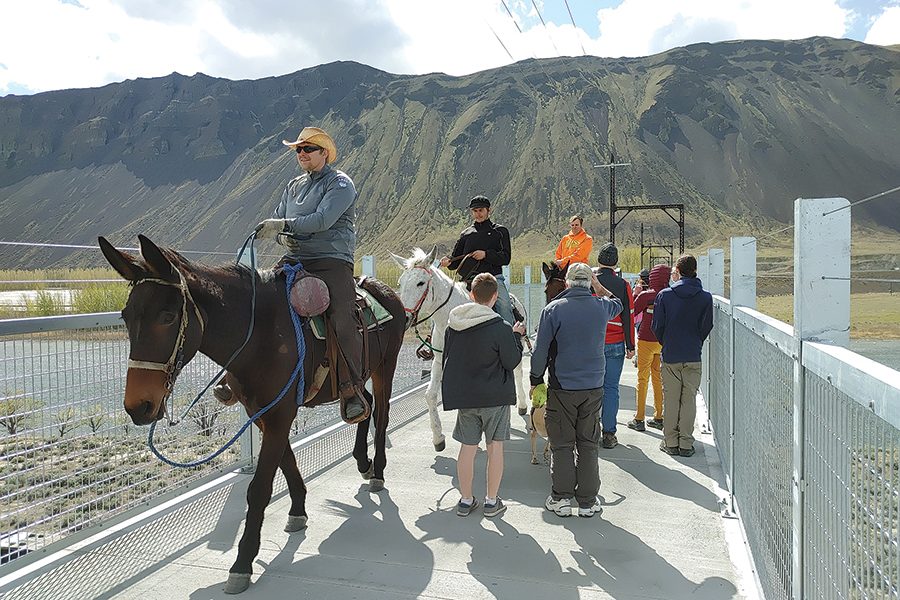
Home » Renovated railroad trestle connects east, west
Renovated railroad trestle connects east, west

May 11, 2022
Fierce wind raked the Beverly Bridge but the challenging weather didn’t deter crowds who turned out to dedicate the Beverly Bridge, the newest link in the Washington State Park system’s Palouse to Cascades State Trail.
Gov. Jay Inslee joined a crowd of more than 300 to officially open the former railroad trestle near Vantage to hikers, cyclists and horseback riders on April 8.
A $6 million facelift transformed the abandoned railroad trestle into a friendly crossing with new decking and protective rails high enough to accommodate people atop horses. It links the two sides of the east-west trail and ends the need to trek north to the Interstate 90 bridge to get across the Columbia River.
State engineers noted the freeway bridge lacks any semblance of facilities for non-motorists, making it a “dicey” proposition for trail users crossing from one side to the other.
Beverly Bridge is more than a convenient bridge. It is a worthy destination on its own, offering sweeping views of a stretch of the Columbia that has hosted Indigenous tribes for millennia.
The children of the late Rex Buck, the leader of the Priest Rapids band of the Wanapum, spoke about a landscape that has nurtured – and been nurtured by – native people since long before a railroad came through.
Johnny Buck said it was home to an 18-mile village and gathering spot. His sister, Lelah Buck, invited future users to experience the sacredness of the setting.
The governor touted the renovation as a commitment to the state’s clean energy future and a symbol of “one Washington,” reflecting its position between the two sides of the state.
He tossed off a dig at California, noting that Washington has the Beverly Bridge, and “California has the Beverly Hillbillies.”
More seriously, the bridge is the culmination of decades of work to complete the state trail along the former Milwaukie Road rail corridor, which extends from Cedar Falls, an unincorporated community in King County, to the Idaho border.
It carries the Washington state segment of the Great American Rail-Trail, a work in progress that will eventually connect Washington state and Washington, D.C.
A Toppenish man working on the rehabilitation fell to his death during construction.
The Department of Labor and Industries fined the Bellingham contractor, Boss Construction Inc., $284,000 for safety violations leading to the death of Gabriel Zelaya, 39. Speakers honored his sacrifice and welcomed his family to the ceremony.
The railroad bridge was built in 1909 as part of the Milwaukie Road Pacific Extension, an electric railway that failed in the early 1970s. By 1980, the bridge was abandoned. The wheels of a railcar that tumbled to the island below are still visible.
What happened next is a testament to the vision of hikers, cyclists and backcountry equestrians who wanted the old rail corridor for public use, said Ralph Munro, who was elected secretary of state in 1981.
Munro, 78, said the railroad corridor presented a rare opportunity. Visionaries spied a statewide public access corridor. Agricultural interests resisted the idea.
As recently as a year ago, critics were calling it a waste of money for a project that would get just a few hundred users a year.
There were a lot of ideas about what to do, Munro recalled.
“If the bicycle people and the horse people and the trail people keep at it, it will happen,” Munro recalled.
In the end, the state paid $4.3 million for the Milwaukie Road and called it the John Wayne Pioneer Trail, after making a concession to a fan of the late western icon.
“One House member wouldn’t vote for it unless it was named for John Wayne, so that’s where ‘John Wayne’ came from,” Munro explained. The John Wayne Pioneer Trail was renamed in 2018.
While the trail took shape on either side of the river, the bridge itself languished. A fire destroyed some of its components.
In 2017, it came to the attention of historic preservationists, said Chris Moore, executive director of the Washington Trust for Historic Preservation.
The trust added the span to its “most endangered properties” list. That alone would not have been enough to save it. But opportunity smiled in the form of BNSF Railway. The railroad needed to remove three historic railroad bridges that crossed Columbia.
Moore said the trust couldn’t block their removal, but it could mitigate the impact. The Beverly Bridge, a steel truss structure regarded as a feat of early 20th century engineering, was the ideal candidate. Repurposing it would save the bridge and support the trail vision.
BNSF provided $125,000 for a feasibility study that sussed out the cost associated with repurposing it.
The project was put in the state capital projects budget and won support from the governor. The Legislature included it in the capital budget and work took off. In addition to Boss, the project team included Exeltech Consulting, the structural engineer, and project manager Adam Fulton of Washington State Parks.
Moore said the Beverly Bridge highlights the powerful impact of dedicated advocates.
“What I wanted to get across is advocacy is tremendously important,” he said.
The bridge is about 90 minutes from the Tri-Cities via the Vantage Highway. Users can access it from the town of Beverly on the east, or travel around via I-90 to Vantage and drive seven miles south on Wanapum/Hunzinger Road to the trailhead.
Learn more about the Palouse to Cascades Trail at parks.wa.gov/521/Palouse-to-Cascades.
Real Estate & Construction Transportation
KEYWORDS may 2022




